Sirena Station is the most popular station in the incredible Corcovado National Park for visitors to hike through the rainforest and beach trails to see wildlife and nature.
Visitors can take a day trip to Sirena Station or opt for an even more immersive experience in one of the most bio-diverse places in the world and stay overnight.
If you’re thinking about booking a Corcovado National Park Sirena Station overnight tour or day trip, then here is all you have to know to plan your once in a lifetime trip.
This post has affiliate links which we may earn a small commission from if you choose to purchase, at no extra cost to you. Listed prices are quoted in USD and are estimates. More info: Disclosure
Important Information About Corcovado National Park Sirena Station Tickets and Tours
Every visitor must purchase a park ticket in advance to visit Corcovado National Park. Each sector: San Pedrillo, Sirena, Leona, Los Patos and El Tigre has their own maximum number of visitors allowed.
Your guide or tour operator will purchase your park ticket for you. Information normally required to purchase your ticket is your full name, passport country, passport number and age.
Sirena, being the most popular visitor station sells out quickly in the high tourism season (December through April).
If you want to book a day trip or overnight stay, you must book it ASAP. If it is under 3 days, tour operators cannot guarantee your park ticket.
In high season, we recommend booking at least 30 days out.
During the lower tourism season months such as May, June, September and October, availability is not as limited, but we still recommend to book your tour as soon as possible to guarantee your spot.
For day trips, the Sirena Station has a maximum of around 500 people. For overnight stays, the maximum number of people allowed including tour guides is around 80 people.
Corcovado National Park Sirena Station Highlights
The Osa Peninsula holds around 2.5% of the world’s biodiversity and Costa Rica created Corcovado National Park in 1975 to protect and conserve the abundant flora and fauna that live there.
Sirena Station offers plenty of opportunities to see wildlife, particularly the Baird’s tapir, Great Currasows, peccaries and spider monkeys.
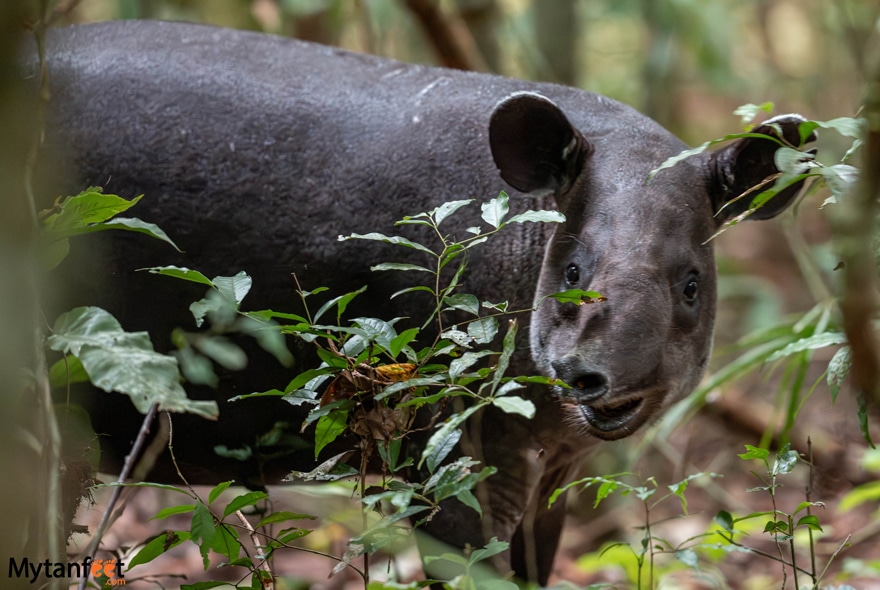
Trails are well laid out and maintained with excellent signage.
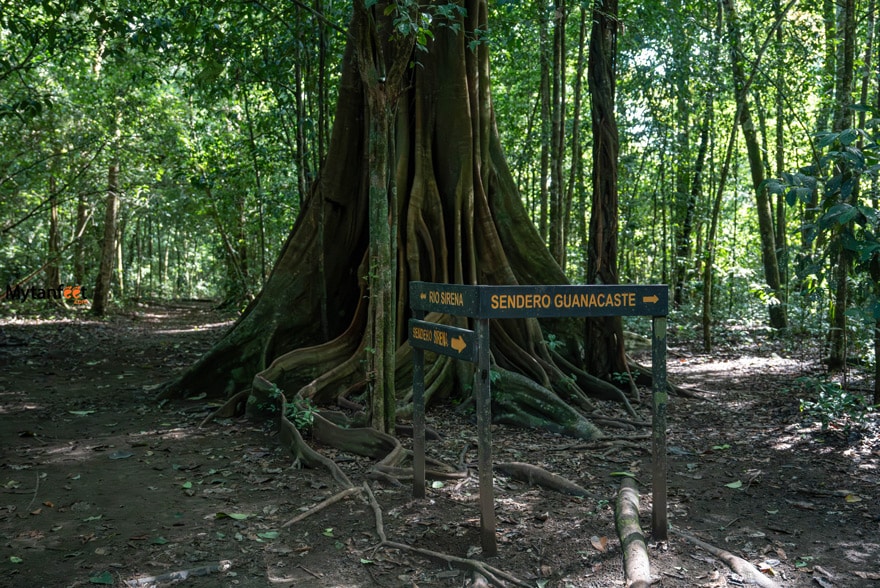
Although the trails do not have elevation, you must be able to walk around 10 kilometers (6 miles) on dirt paths with rocks, roots and mud through a hot and humid jungle.
The entire tour consists of a lot of hiking at a moderate pace. You’ll stop if the guides see something.

Trails go along the beach and through the forest, offering beautiful views of the Osa Peninsula coastline and tropical rainforest.
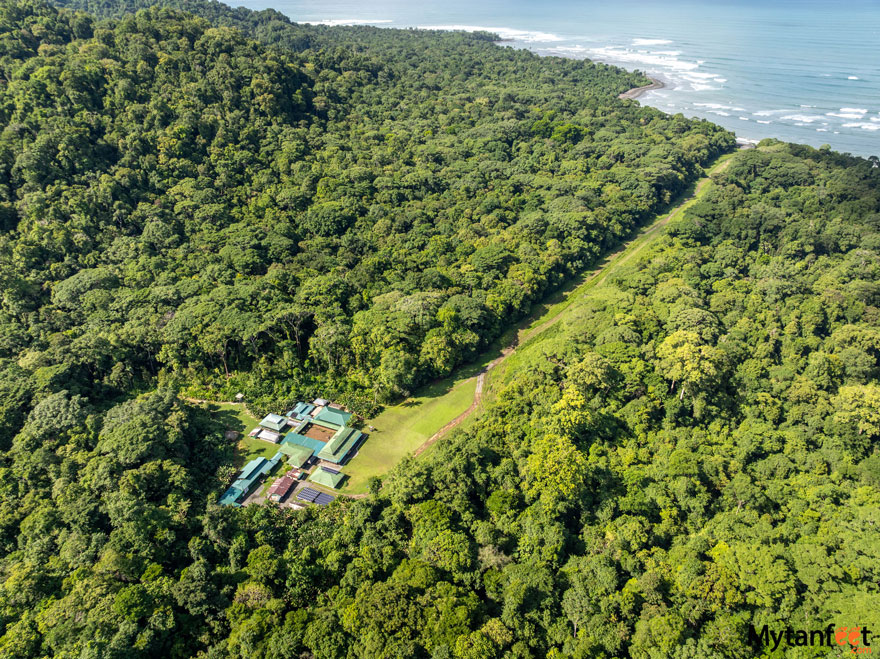
In addition to welcoming day trippers, Sirena Station is fully equipped for overnight visitors.
Corcovado National Park Sirena Station One Day Tours
Sirena Station one day tours are available from Drake Bay and Puerto Jimenez.

Shared tour groups normally have a maximum of 8-10 per guide. Private tours are also available, at a higher cost.

The day trips are are full day tours (~8 hours) with early morning start times.
From Drake Bay
Includes: Bilingual guide, national park fee, lunch, boat ride.
Approximate cost: $110 – $160 USD per person. Prices depend on the tour operator.
Rough Itinerary
- 6 AM departure by boat from Drake Bay
- 1 hour boat ride to Sirena Station
- 4-5 hour walk on the trails around the station
- Lunch at the station around 11 – 1130 AM
- Leave Sirena Station by boat at 1230 PM back to Drake Bay
Some tour operators offer an 8 or 830 AM departure from Drake Bay with a 4 PM return.
Book your Sirena Station day trip from Drake Bay.
From Puerto Jimenez
Includes: Bilingual guide, national park fee, lunch, boat ride.
Approximate cost: $160-80 USD per person. Prices depend on the tour operator.
Rough Itinerary
- 530 AM departure from Puerto Jimenez dock
- 1.5 hour boat ride to Sirena Station
- Walk for about 4-5 hours
- Lunch at the station around 11-1130 AM
- Depart by boat to Puerto Jimenez at 1 PM
Book your Sirena Station day trip from Puerto Jimenez.
Sirena Station Day Trip Information
Total walking distance is around 5-10 km (3-6 miles) on flat dirt paths and sandy beach shores. You’ll start your walk as soon as you get off the boat.
The boat ride can be a bit bumpy depending on weather conditions. The boats are covered speedboats that hold 10-15 people.
You may see turtles, dolphins and humpback whales (December through March and July through mid-October) along the way.
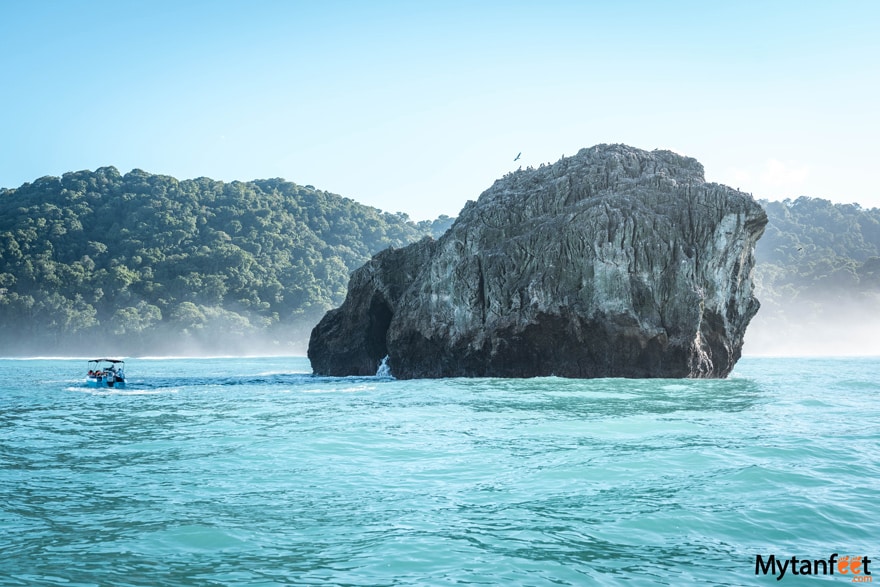
From Puerto Jimenez, you will get the the boat from a dock. From Drake Bay, it will normally be a pick up from Agujitas beach or from your tour operator’s office.
When you arrive at Sirena, the boat will get as close as possible to the beach. Be prepared for a wet landing.

Lunch is a traditional Costa Rican lunch, normally with rice, beans, salad and a protein.
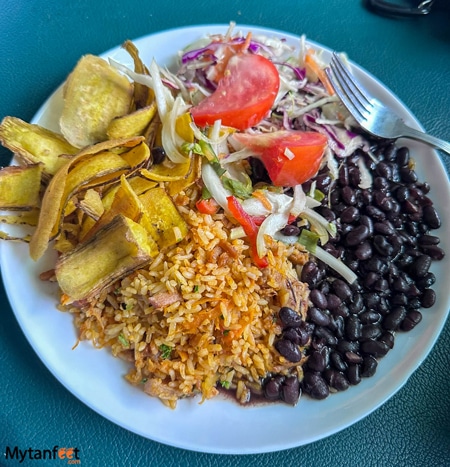
They are very good about food allergies and diet restrictions, but you have to inform your tour company/guide.
Corcovado National Park Sirena Station Overnight Tours
For an even more intense experience in the rugged and wild Corcovado National Park, stay overnight at Sirena Station.
Tour operators offer 1, 2 or 3 night packages. Most people don’t stay longer than 3 nights. You can choose to hike in & boat out, boat in & hike out, hike in and out or boat in and out.
Included: All meals from pick up to return, lodging, bilingual guide, national park fee. Free Wi-Fi in the common area.
Not included: Lockers, towels, rain boots (available for an extra fee).
Rates: This depends on what type of tour you choose.
Average cost starts at $450 USD per person for a 2 days, 1 night boat in and out from Puerto Jimenez. Average cost starts on average around $350 USD per person boat in and out from Drake Bay.
Book your 2 days, 1 night Sirena Station Overnight from Puerto Jimenez.
Book your 2 days, 1 night Sirena Station Overnight from Drake Bay.
Should You Hike or Boat In/Out?
Most people boat in and out, but if you’re in great shape and up for an extreme jungle experience, you can do hike, either one way or both ways.
The hikes in/out from Leona and Patos station are intense.
The hike from La Leona is 16 kms (9.94 miles) and the hike from Los Patos 20 kms (12.47 miles), both through dense rainforest and requiring river crossings.
You have to carry everything with you and you must be with a guide.
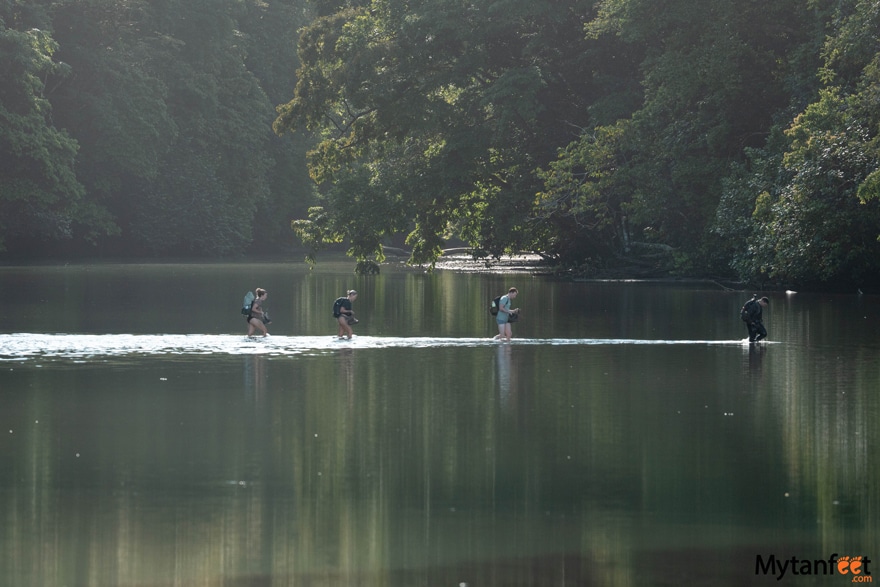
You obviously experience more of the national park by hiking, but not everyone wants to or can hike that distance through a humid and hot jungle.
It’s definitely a bucket list experience though! We hope to do both hikes from Leona and Patos to Sirena one day.
Lodging at Sirena Station
The station has a large dining hall, a souvenir store, a small museum and a veranda along one side. The veranda is a nice spot to chill, sit and look out into the trees as it faces the forest.
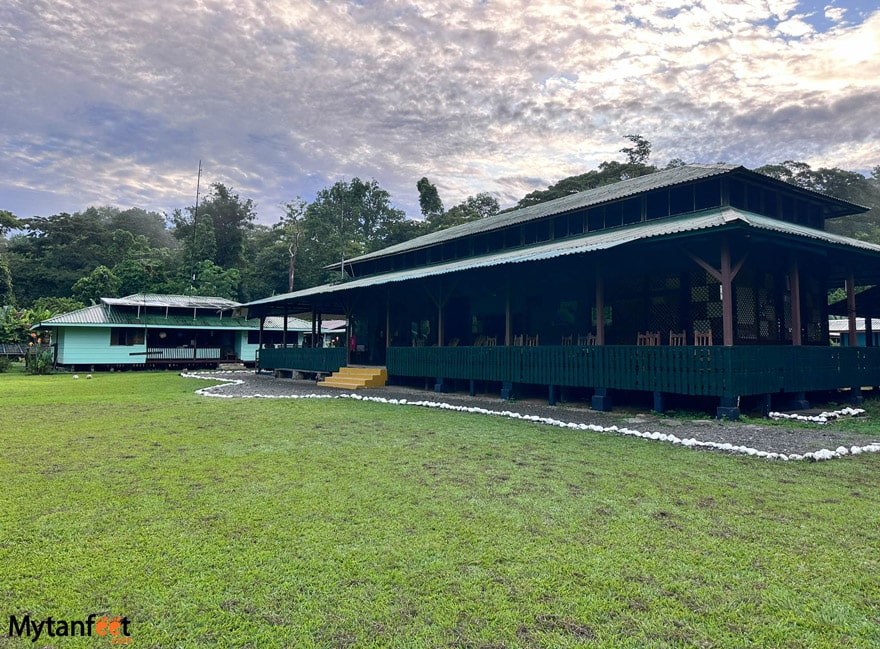

Sirena Station has two open air dorm rooms with bunk beds. Every bunk bed is covered with a mosquito net and has a mattress with a fitted sheet, one pillow and a top sheet.


There are four to five showers and four to five restrooms for each gender, as well as six sinks.
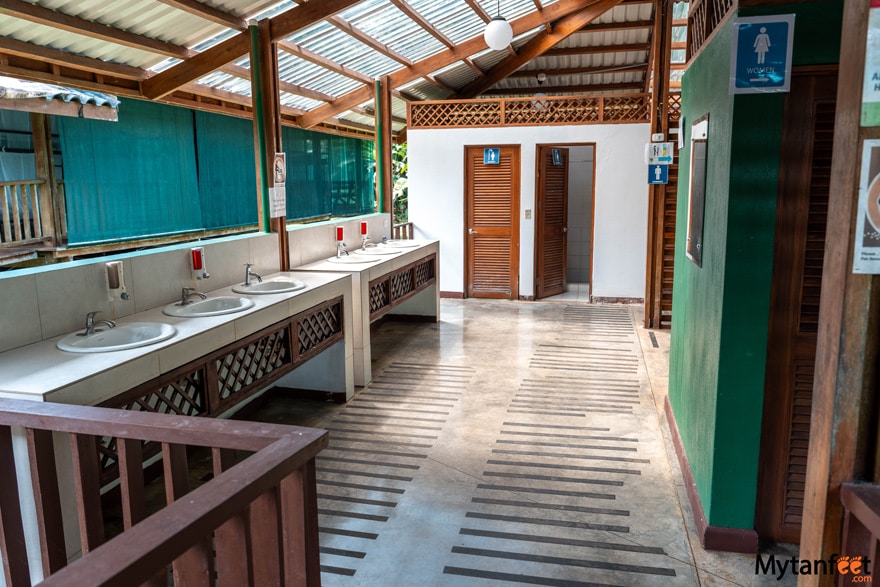
There is one bathroom with a changing table inside for babies.
The lodging is basic, no frills, no bells and whistles.
In high season, the station is often at maximum capacity. Don’t forget ear plugs!
Before and After Your Overnight Trip
Most people leave their big luggage behind in Puerto Jimenez or Drake Bay and bring one backpack with all their essentials and one small day pack or hiking pack.
If you are coming from Puerto Jimenez or Drake Bay, many hotels will allow you to leave your car and/or luggage, as long as you stay the night before and/or after your trip.
We stayed at Cabinas Refugio Turistico in Puerto Jimenez the night before our Sirena Station overnight trip. They allowed us to leave our car with luggage inside their property.
When we came back, we stayed the night at the Botanika Osa Peninsula Curio Collection by Hilton. They also allow guests to leave their car.
Find out how to get to Puerto Jimenez to plan your trip. You can also read about how to get to Drake Bay in this link.
What to Bring For an Overnight Stay at Sirena Station Corcovado National Park
Essential items: mosquito repellent, hat, sunscreen, toothbrush, toothpaste, shampoo, soap, your own essential toiletries, flip flops, closed shoes, ear plugs, fully charged battery pack, insulated water bottle, laundry bag, comfortable hiking clothes, eye mask.
Clothing: Lightweight, dry fit, moisture wicking clothes. It is incredibly humid. We prefer to wear long lightweight hiking pants to ward off mosquitoes.
Backpack: One backpack to carry all your stuff and a second day pack or light hiking backpack for when you are on the trails.
A waterproof rain jacket, backpack rain cover, dry bags or a waterproof backpack is mandatory in the rainy season (May through November).
Shoes: Shoes are not allowed inside the station. You can only enter barefoot or with slippers/flip flops. Open toed shoes are not allowed on the trails. You must wear hiking shoes/walking shoes/trail running shoes.
The station has rain boots for rent. In the rainy season, I highly recommend renting boots as the trails can get very muddy.
For getting on/off the boat, we recommend water shoes. Then once you’re on the beach, you can change into your hiking shoes. Bring a small hand towel to clean and dry your feet.
Towels and lockers are available to rent for a fee ($5 USD).
Hair dryers are not available so if you use one, bring your own. There is no hot water. The shower is a cold jet of water.
*Single use plastics are not allowed, they will confiscate plastic water bottles. Bring an insulated water bottle. They have stations with filtered drinking water to fill up your bottle.*
Bring a fully charged battery pack with a cable. There are only a few outlets inside the station to charge your phone and electronics. They are by the sinks and a couple in the dining hall.
*Lights out is at 8 PM sharp.* They leave the bathroom light on. Bring a small flashlight.
The day normally starts around 430 AM as people start getting up for the 5 AM walk.
Tips for Photographers
Bring at least 2-3 extra fully charged batteries. Empty your SD cards beforehand and bring 1-2 extra.
You must have a telephoto lens if you want wildlife photos, at least a 300 mm. I used a 200-600 mm Sony lens. Yeison used a 300 mm, sometimes with a 2x Teleconverter.
Yeison used a monopod during the hikes. I went handheld for much of it though I wish I brought my monopod. When we sat on the varanda, we used our tripod.
Bring a waterproof backpack, camera rain cover and a lens rain cover.

If you’re not a photographer, we HIGHLY recommend bringing a pair of binoculars. Guides will have telescopes that you can look through, but you will likely have to wait your turn and the animal may be gone by then.
Guides can take photos through the telescope with your cell phone.
Corcovado National Park: Sirena Station 2 Days, 1 Night From Puerto Jimenez Itinerary
We stayed at Sirena Station for two days, one night from Puerto Jimenez, boating in and out. Our trip was mid June, in the rainy season.
If you have any questions about visiting Sirena Station for a day tour or overnight, please feel free to contact us.
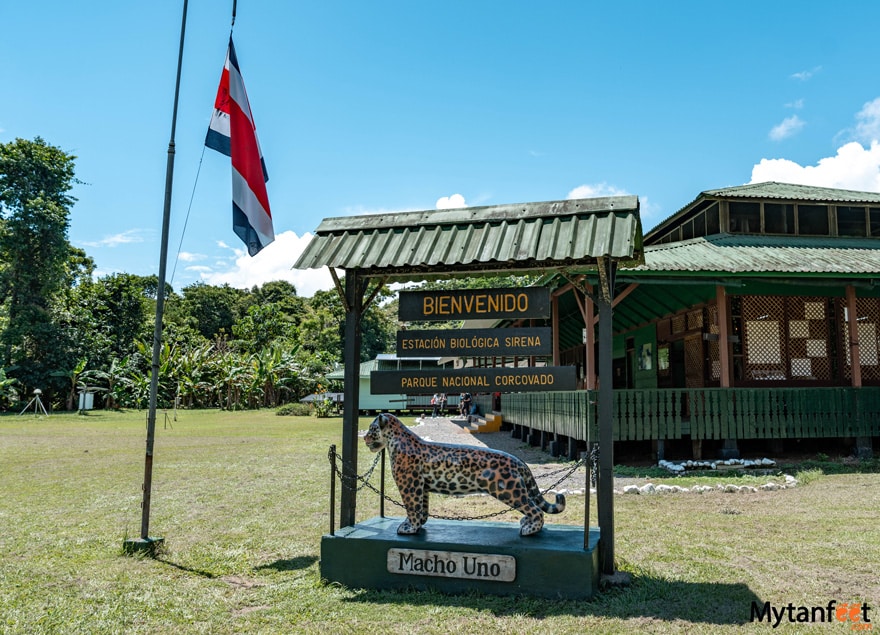
Though we did get rain, there were way less people at the station. We still saw lots of wildlife as it did not rain non stop.
For the overnight stay, only five of us slept in the station. In the high tourism season, the station can be at maximum capacity.
Day 1 Leaving from Puerto Jimenez
We woke up at 430 AM to grab some pastries at the bakery. Then we headed to the Puerto Jimenez dock around 520 AM to meet the boat.
Our first day itinerary was exactly the same as the day trip guests, but after lunch, we went for another walk around 2 PM.
We walked for about 3.5 hours, until it started getting dark. Remember, it gets dark by 6 PM everyday in Costa Rica.
Even though early morning typically is the best time to see wildlife, we still saw a bunch in the late afternoon walk.
We saw spider monkeys, howler monkeys, mot mots, trogons, crocodiles, Great Currasows, Tiger Herons, hawks, Ospreys, a peccary, Yellow Throated toucans and Scarlet Macaws.
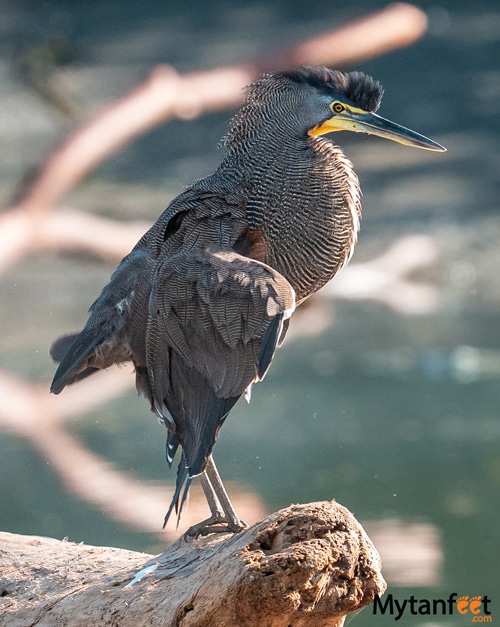
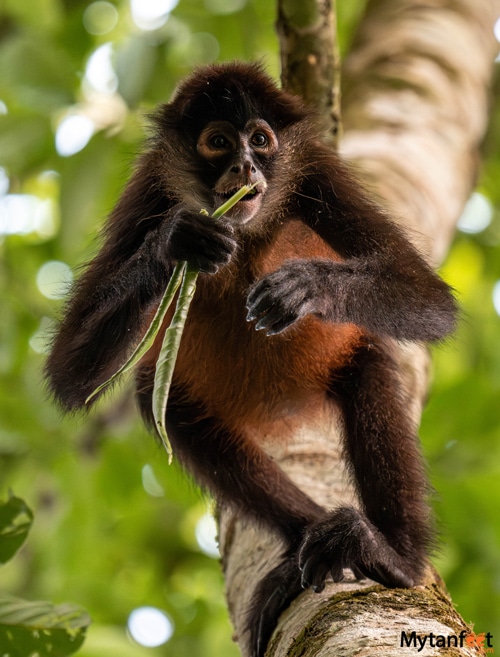
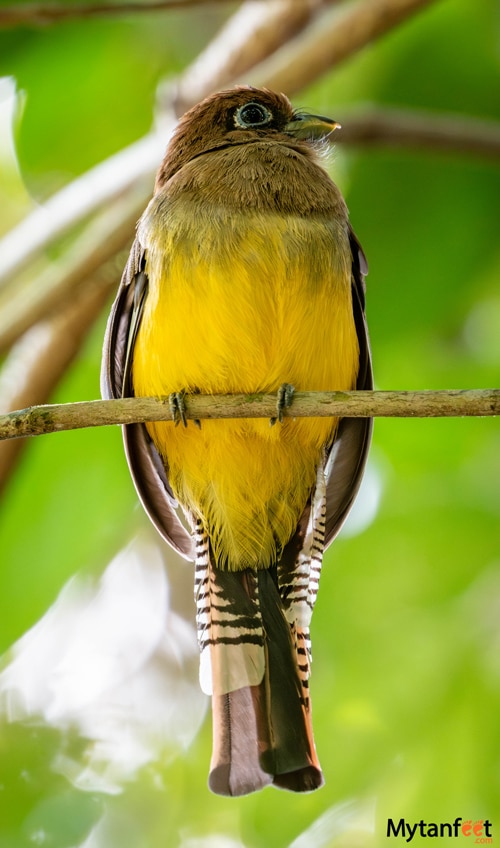
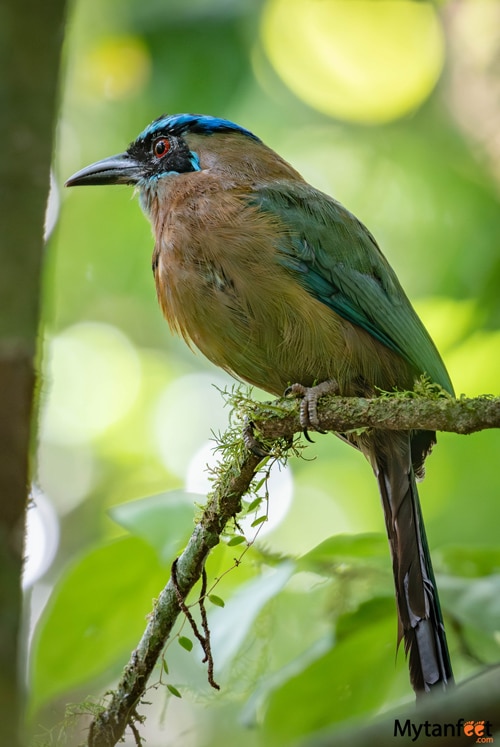
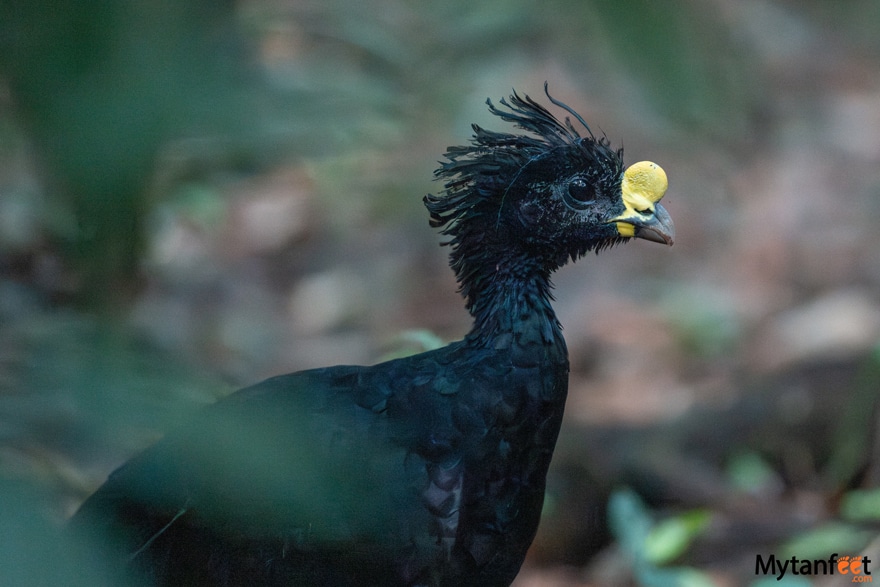
Luck was also on our side that day because in the afternoon, we saw four tapirs. Yes that’s right – FOUR tapirs!
At 4 PM, we saw one swimming in the Sirena River, at 5 PM we saw a mom and baby on the Sendero Naranjo and at 530 PM, we saw another walking across the field in front of the station!

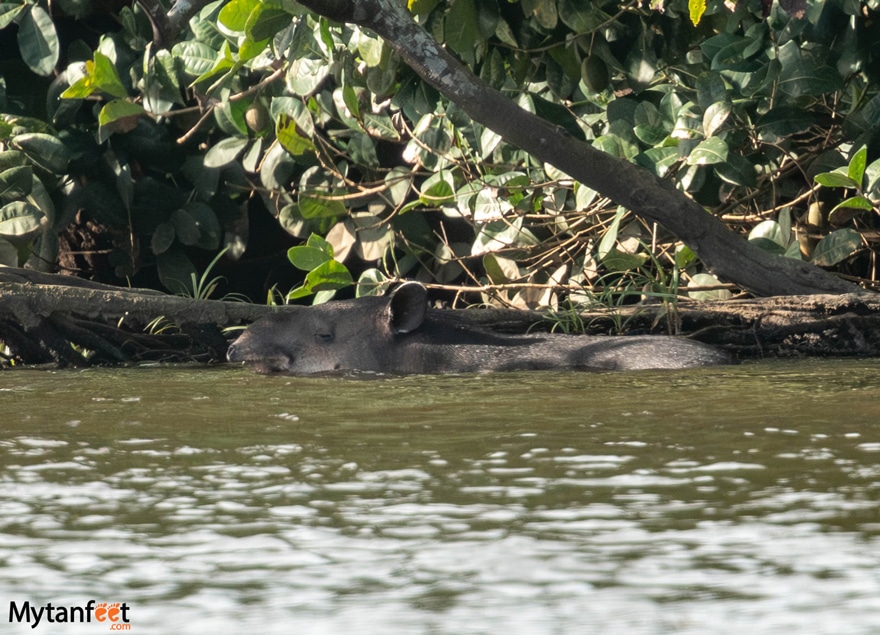
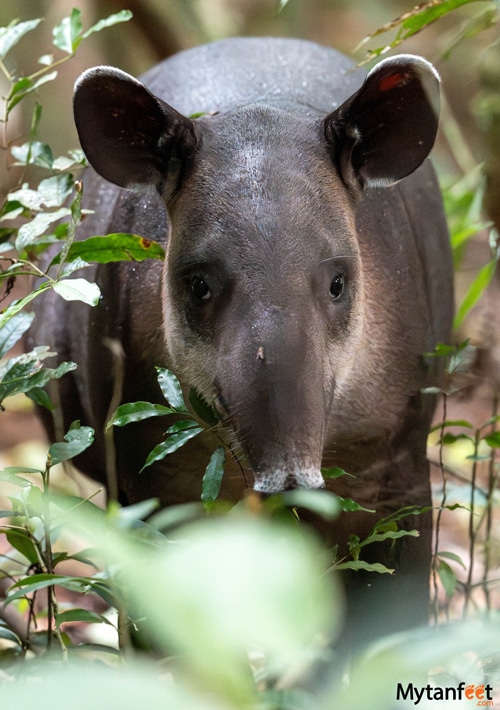
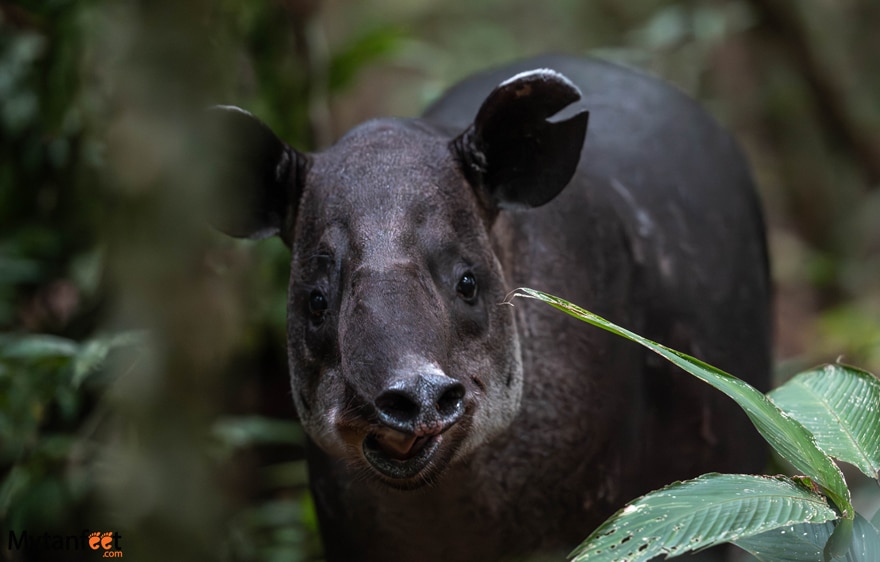
None of the day tour groups saw a tapir, so we felt so lucky to see so many after everyone left.
After our afternoon walk, we relaxed and chilled on the veranda. Then we had dinner at 6 PM. After dinner, we showered and pretty much went to bed when lights went out at 8 PM.
We had fantastic weather that day. No rain, only sun. The rain came later that night, around midnight though!
Day 2 Morning
On day 2, we woke up at 445 AM. We began our first hike right away around 5 AM, until about 730 AM. We saw more spider monkeys, a peccary, herons, hawks, vultures and a sleeping tapir.
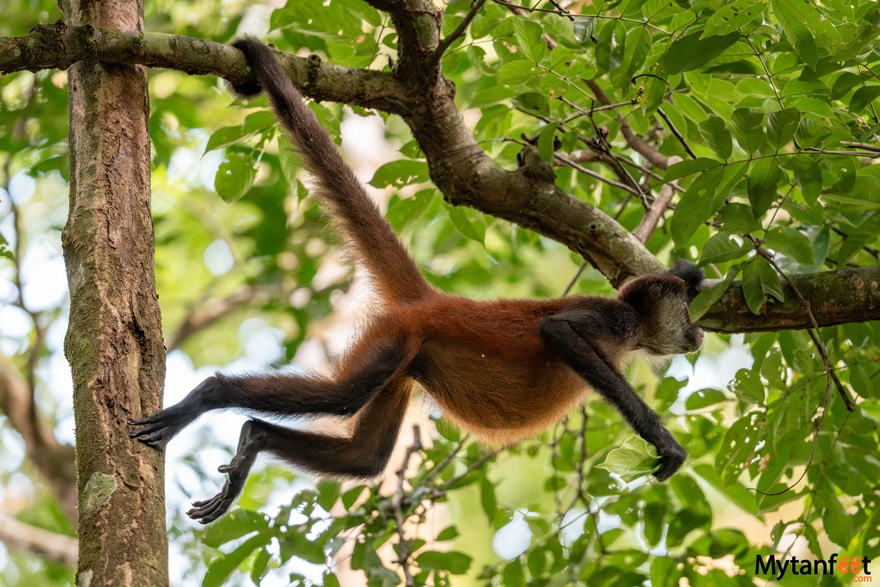



After our walk, we had breakfast at the station and then relaxed on the veranda for a bit. Around 9 AM, we went on a second walk for 2 hours.
When we returned from the second walk, I bought some shirts from the souvenir store and got all our luggage ready to leave.
Our boat picked us up at 1230 PM on the beach outside the station and we got back to Puerto Jimenez around 2 PM.
It started pouring rain around noon. We got absolutely drenched on the boat ride back.
End of Day 2
We picked up our car and stayed at the Botanika Osa Peninsula that night. Originally, we planned to drive to Uvita (2.5 hours), but we were too tired.
I’m SO happy we stayed in Puerto Jimenez that night because we were exhausted from the past 30 hours! It also began to rain really hard after we arrived back to Puerto Jimenez. We didn’t want to drive in that storm!
Additionally, we didn’t sleep great at Sirena Station. Even though there were only five people sleeping at the station, it rained really hard throughout the night, waking me up often. I should have brought ear plugs.
Despite the mosquito nets, a couple nasty ones got in and feasted on my hands. I highly recommend putting on natural mosquito repellent when you go to bed.
More than 1 Night
If you are staying more than 1 night, your extra days will consist of more hiking the various trails around the station and on the beach with your guide.
That means more opportunities to see more animals!
Weather
The best time to visit Sirena Station for weather is the dry season, which is December through April. However, it can still rain a bit during the first and last month of the dry season as the weather is transitioning.
The rainy season, May through November, usually has dry mornings and then on and off rains during the rest of the day. October is the rainiest month and it can storm the whole day.
I have visited Sirena Station once in January for a day trip and it was a super hot and sunny day. No rain at all.
We did the overnight stay during mid June. The first day was gorgeous. Partially cloudy and sunny, no rain. It started raining hard that night. The second day poured rain around noon and for the rest of the day.
Temperatures do not vary greatly throughout the year. Average day time temperatures are 85° F (29° C). Night time temperatures go down to about low 70s° F (21° C).
It’s extremely humid in this area, always hovering around 80-90%.
When it rains, it is still hot, it’s warm rain. As it can go from rain to sun in a matter of minutes, it can feel like an intense sauna.
Video
Below is a video of our Corcovado National Park Sirena Station overnight stay from Puerto Jimenez. Watch our experience below!
If you have any questions about visiting Sirena Station for a day tour or overnight stay, feel free to contact us.
Costa Rica Vacation Checklist
- First time to Costa Rica? Read our First Time in Costa Rica guide.
- Not sure how to move around Costa Rica? Read our How to Get Around Costa Rica guide to find the best transportation method for you.
- Click the link to get our detailed Costa Rica Packing List so you know what essential items to bring.
- Check our Costa Rica destinations map and Costa Rica restaurant map
- Do not forget to purchase Travel Insurance for your trip to Costa Rica.
- Stay connected by purchasing a prepaid SIM Card in Costa Rica.
- Save money with Mytanfeet Deals for tours and hotels and our Costa Rica Car Rental Discount.

Michele says
We’re staying in Drake Bay for 3 nights. Hotel and tours are paid for. How much should we bring in colones and USD? Since there isn’t an ATM in town, we want to make sure we’re covered.
Sammi says
Depending on if your hotel provides food or if you need to go out to eat each meal, I’d bring around 250,000 CRC per person in case you decide to add activities, but if you book activities through your hotel most of them should take credit card, unless you’re in a really low budget place, then they may be cash only.